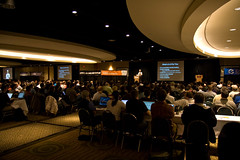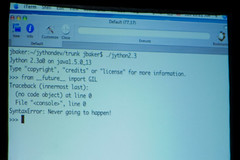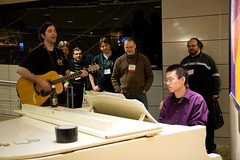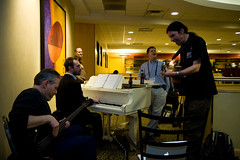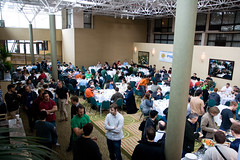A little more than a year ago, I gave myself a birthday present and took Zack Arias’ OneLight workshop when it was here in Seattle. I had been reading David Hobby’s Strobist blog for some time, but there was something about the time that I spent at the OneLight that brought it all together for me. If I know anything about lighting at all it’s in large part because of David and Zack. Zack has been working on rebranding himself, and has just launched a new blog. I’ve already subscribed, and if you’re interested in lighting, you should too.
Monthly Archives: March 2008
On Conferences
Bruce Eckel was unhappy about some things that happened at PyCon and wrote about them. A lot of his concerns are relevant to conferences in general, so I decided to break this into another post. The PyCon one was getting long. The crux of his dissatisfaction was that he felt that sponsors had been given too much access to the conference content (keynotes and lightning talks) in exchange for their sponsorship. I agreed with this and I told Bruce that in person. Frank and I were given a sponsored lightning talk slot, which we used to try to explain our new jobs to the Python community. Having been to PyCon previously it was a bit uncomfortable to be there in a “priority scheduled” slot. No sane company would want to make a bad impression on the attendees of a conference, yet in aggregate, this is precisely what happened this year. Having also talked with some of the organizers during sprint week, I am pretty sure that this will never happen again.
Predictably, there has been a lot of commentary, in response to Bruce’s post. Lots of people are upset for various reasons. Attendees are unhappy for one reason or another, and organizers and volunteers feel that they have worked a thankless task only to be kicked in the teeth.
I am both happy, and unhappy. I love PyCon. I love it even more than ApacheCon, because it has managed to retain more of that volunteer spirit. While there was a production company involved, from what I was able to see, the volunteers are still doing most of the work. I think that this is incredibly important, because no production company can know a community as well as a diverse set of volunteers drawn from the community itself. Without that knowledge, it is very hard to do a good conference.
Even with intimate knowledge of a community things are still complicated. The Python community itself is diverse, and growing. That means that the community is going to have different segments in it. I would be willing to be that there were a lot of people who came to PyCon to kick the tires on Python and it’s associated technologies, or to learn something new after maybe a year or so of programming in Python. Those folks have very different needs from people like Bruce or me. Bruce isn’t really interested in an eyes forward conference, and neither am I for the most part (unless Armin Rigo is going to talk about abstract interpretation o r partial evaluation). But many folks coming to a new topic area are looking for stuff more like tutorials, and introductory talks, which tend to be eyes forward stuff.
The key here is for everyone to have enough choices, and to me, that means that a good conference (not just PyCon) will look something like this.
- The Hallway track – this just happens
- Open Spaces for long time community members and/or advanced/specialized topics – this needs modest resources but needs promotion so that people understand how important these are and how to use them. O’Reilly has run OSCamp alongside of OSCON for a few years now, but OSCON is always played up as the major thing. But in today’s day and age, I think those roles probably ought to be inverted.
- Lightning Talks – I am sad to admit that I want to far too many conferences where I ignored the lightning talks – to my detriment. I think that we owe the Perl folks a rich debt for having come up with the idea. Educating people on the value of lightning talks is good. I’d like to see the lightning talks moved to a more prominent spot, say, earlier in the day. I also think it would be worth soliciting a few people to give a lightning talk.
- Regular Talks – If you are giving a real/regular talk, then I expect a lot. If you start reading to me about your project, I will be unhappy, because I guarantee you that I can learn more about your open source project by reading your project website during your talk than by listening to you. If I can’t, then there are larger problems a foot. You need to really say something really interesting or unusual in order to give a talk.
- Keynotes – keynotes either need to be expansive, of incredibly broad interest (like python-3000, which Guido himself said was getting boring to talk about, since it’s been the same talk the last 2-3 years), or very entertaining. Best example of very entertaining would be the end of OSCON keynotes by the guys from WETA digital featuring theretofore unseen footage from the Lord of the Rings movies
- Tutorials – this is basically old hat, but the people that need them, really need them
Also, for PyCon, we need to keep up the tradition of code. I loved walking down those hallways at GWU and seeing people huddled in pairs over a laptop cranking stuff out. It was amazing this week to walk through the entire downstairs area and see all the sprint labels on the doors.
One other note on conferences. Twitter is it. As usual, there were some difficulties with the PyCon WiFi – first time in a hotel that has never hosted geeks before, so it was inevitable. For those of us not smart enough to bring an EVDO card and router, getting connectivity was tough. The reason I missed that the most was the Twitter backchannel. There was an official pycon twitter feed (a bot, I’d guess), but there was also the backchannel of friends. Here are some real life examples of Twitter in action at PyCon.
- Bruce Eckel decided to host an open space on concurrency, a topic I am really interested in. The only way that I found out about it was that Dianne Marsh, twittered it to the pycon reflector. I managed to get there in time for some interesting discussion, and to see who else was interested in the topic.
- During the sprints, Donovan Preston was tweeting things like
-
which ultimately goaded me into going down the hall to find out what he was up to.
The value in conferences is all being there together. There are plenty of different ways to structure that time together, each able to serve a different kind of audience. Why not have them all and give people a choice?
PyCon 2008
It’s been 2 years since I’ve been to PyCon, and things have definitely changed. The last time I went to PyCon (2006 in Dallas), it was still a relatively small conference (3-400), if I remember what I was told), with a familiar feel, especially if you had attended in previous years, or were a part of the Python community. This year, there were over 1000 people (double the 500 people that came in 2007, apparently). I spent a sizable portion of the conference days feeling like “I miss a year, and you guys go and get 1000 people”. It’s a great thing that so many people are interested in Python.
The talks
I went to a reasonable number of talks – talk quality at PyCon has historically been pretty good, and I was a little out of date on the latest on things like Django and Turbogears. The best talk that I went to was Raymond Hettinger’s talk “Core Python Containers — Under the Hood”. This was a great talk for several reasons: Raymond was a good and entertaining speaker. There was significant technical meat – explanations of the implementation choices for all the core containers in Python, lists, sets, and dicts. We heard about doubling factors and amortized big-oh time. Most importantly, there was significant practical applications for Python programmers. Raymond’s talk gives a cost model for the core containers, and having an understanding of that model is important for folks who are writing Python programers. It’s also useful for developers of alternate Python implementations because it allows them to follow suit or to diverge and (hopefully) document the places where the cost model is different. My next favorite talk was Jim Baker’s “More Iterators in Action”. I missed the talk given last year, but I liked this one. Jim hit two of my favorite topics, language integrated query (LINQ) (albeit without the DSL), and concurrency.
Concurrency
There was a lot of interest in concurrency this year, which warms my heart, because I see high-level/dynamic languages and concurrency as the chocolate and peanut butter in the old Reese’s peanut butter cup commercials. There were 2 open space sessions and 1 lightning talk, and the topic entered many of the conversations that I had.
Sun, Jython, and JRuby
People were generally positive to learn about Sun’s interest in Python and Jython. A number of people stopped me to congratulate me on the new job, and we had a nice turnout at the open space session, where people were free with ideas, comments, and a few not so easy to answer questions. I hope that Sun can live up to the goodwill that people extended towards me and Frank.
If I was surprised about the jump in size of PyCon, I was even more surprised by the amount of energy around Jython. At most of the previous PyCon’s that I attended, people would mention Jython, and either be sorry that it was too out of date to consider, or be just plain dismissive of it. This year there was none of that. People were very interested in Jython. I was really surprised by how much interest there was, and by some of the people who were interested. It was certainly a nice feeling to sit in the sprint room and occasionally have people pop in to ask if such and such was running in Jython yet, or did Jython support X because package Y needed it.
This was the first time that I had met Frank Wierzbicki in person — I think he’s the happiest person at Sun right now. I was also able to spend some time hanging out with various folks from the Jython community. It seemed to me that the community was doing quite nicely. If you looked at some of the community metrics that we would use at the ASF to allow a project to graduate from incubation, almost all of those criteria have already been fulfilled. One of my goals for Sun’s Python efforts is for as many of them as possible to be highly community oriented, so it was nice to see that Jython is well on it’s way in that regard. The folks working on Jython are very sharp (including the aforementioned Jim Baker, who it turns out was a classmate of mine at the Brown CS dept – although neither of us can remember meeting the other), and have one of the those (in my mind) essential community ingredients, a community sense of humor.
Jim snuck this bit of commentary on Jython’s lack of a global interpreter lock into his talk.
There were several Ruby related surprises at PyCon this year. David Heinemeier Hansson, create of Ruby on Rails, made an appearance for one day, and a number of the JRuby committers made a road trip down from Minnesota, to hang out, meet the Jython folks, and generally display their hacker prowess. Which they totally did. Charlie and Tom powered their way to JRuby 1.1RC3 during the conference. Meanwhile Nick Sieger demonstrated what a happens when you stick a bunch of hackers, an EVDO card, and an EVDO hub into a car. The Jython guys (if any of them lived in the same state) need to get some of that – The best thing since the Adobe AIR Bus Tour, and at a fraction of the cost.. The JRuby folks and Jython folks are already starting to talk and share experiences, and I am sure that this will only result in even better dynamic language stuff for the JVM.
Other Cool stuff
On one of the sprint days, I did a bit of wandering and stopped to talk to my friend Brian Dorsey, who is doing some cool stuff here in Seattle. Brian was working with Richard Jones on pyglet and Bruce. Pyglet is a set of Python libraries for writing games and doing other kinds of multimedia. There’s pygame, which I am aware of because of Armin Rigo’s infamous use of pygame to deliver talks about PyPy. Richard has created Bruce, a presentation tool based on pyglet. In addition to being able to do cool multimedia presentation effects, there are some really cool things that you can do. Perhaps the coolest is that you can have a slide which is essentially an embeddd Python interpreter, so no more switching out of your presentation to demo your Python code at work. Really slick.
On a different note, on several evenings, conference goers who stuck around to hang out in the hotel’s common area were treated to musical performances by a dynamic (as in constantly changing set of members) band of Pythonistas:
The Sprints
Perhaps the most amazing way in which the conference has changed is this picture.
That is a picture of a part of the lunch crowd on the first day of the sprints following the conference. When I talked to David Goodger about it, he said that he had taken a count and there were over 250 people at the sprints. Visually, that sprint lunch room looked to be about the size of the room for the first PyCon that I attended (PyCon 2004). Simply amazing. The ASF has a hackathon before every ApacheCon, but I can’t remember one ever reaching this kind of size or scale. Another thing about the PyCon sprints is that they are aimed at growing the community — you don’t have to be a committer on any project in order to attend, and experienced project members will take time to sit and help new people get started. There were several people like that in the Jython sprint room. I was more impressed by what happened with the sprints than any other part of the conference. The only central organization here was that the conference planners obtained sprint space, and in a few cases got some sponsors to cough up money for lunch. Everything else was organized by the projects themselves (I heard that the Django folks closed 100 bugs in a single day). If you want to get a sense of what kinds of things got accomplished at the sprints, you can look at this page on the wiki — it’s not exhaustive, but it’s a start.
Travel
In the past, I’ve had some travel nightmares getting home from PyCon. This year I am happy to report that I didn’t have any problems at all, except for a fight that I had with the Sun internal travel system (and lost).
Conclusion
It was great to be back at PyCon. Interest in Python is growing (as measured by attendance), as is interest in Jython, and interested people are also rolling up their sleeves and pitching in (as measured by sprint attendance growth).
PyCon: Open Space with Sun folks
For those of you at PyCon, Frank Wierzbicki and I will be hosting an open space session on Saturday (tomorrow) at 2pm for people to come and tell us what they think Sun should do in the Python space. We are definitely interested in input and feedback from the larger Python community. If you aren’t at PyCon but have ideas, you can drop either of us e-mail. Our Sun e-mail addresses are <firstname>.<lastname>@sun.com.
Watch out for my camera at Pycon
David Goodger asked if I would take some photographs for the conference while I was at PyCon, to which I happily agreed. So fair warning that if you come near my camera, you may end up in my Flickr stream.
Update: PyCon pictures will be tagged “pycon2008”
If you think my job is all about Jython, you are confused.
Apparently people are confused about what I am working on at Sun, and with PyCon starting tomorrow, this is not a good thing. I am not going to be working on Jython directly, although I will certainly be poking my nose in to see what’s going on. The Python related part of my job (which will be the majority in the short term) is to figure out what Sun should be doing in the Python space, across all of the relevant platforms at Sun, including but not limited to: the JVM and JEE, Netbeans, and Solaris.
Sun isn’t done in the dynamic language space, and I will also be looking for opportunities with other dynamic languages and related technologies.
Lazyweb: Virtualization software
I am looking at building a bunch of virtualized machines, and I have no idea what software I should be using.
- I want to create and run images on Linux and OS X
- I want those images to be runnable on Linux, OS X, and Solaris (optional)
- I want to make images that run Linux, Windows, and Solaris
- I want to run one set of images on a box connected to the internet, and have those images appear as separate machines.
- Bonus round: I want there to be some ISP/hosting provider that I can send images to and have them hosted.
I am assuming that my choice are: VMWare, Parallels, and VirtualBox.
Useful pointers and advice appreciated.
Stefano is looking for a job
My good friend Stefano Mazzocchi is looking for a job. If you are looking for a good person for your organization, you should definitely take a look before he’s taken.
Google Contacts and CardDAV
Earlier this week Mark Nottingham wrote about CardDAV and DAV based protocols:
All of this led me to mutter ‘DAV WTF?’ at the IETF APPS Architecture Workshop the other week. Do we really need to give folks the opportunity to mint more application-specific methods and headers?
Interestingly, Lisa Dusseault — one of the core folks in the DAV world — blogged about this the other day;
Were I to propose CalDAV today it would probably be CalAtom — some things would be easier, some harder, but it would catch a wave instead of drifting in the tail of something that was never much of a popular wave. Oh well, we needed something then, and WebDAV gave the most leverage at the time.
I gave a big sigh of relief when I read that, and I hope that the CardDAV folks take this to heart. Some parts of WebDAV (e.g., properties; see Yaron and Larry on this) deserve to be taken out back and shot — although, as Lisa says, they were necessary because of the state of the art at the time. That doesn’t mean we can’t do better now.
Almost as if in answer, yesterday Google announced the release of the Contacts API, which is AtomPub/GData based. Unlike CardDAV, it’s not based on vCard, which is both a blessing and a curse, since lots of popular contact systems (like the Mac address book) know how to export vCard information, and because vCard provides a very rich model for information about people. I’m not sure whether this is progress or not.
The Sun is going to shine on Python
Today is my first day as a Sun employee.
How?
Tim Bray was one of the first people to respond to my “looking for a job” blog post. I have not written about it much, but I’ve been very impressed with how Sun has handled the JRuby project. Tim told me that Sun was interested in ramping up their support for Python in a similar fashion, and asked if I would be interested in coming to Sun to lead such an effort.
Why?
After a bunch of talking and interviewing and so forth, it turns out that I was very interested. Long time readers know that I am a dynamic languages guy, going back to the original dynamic language, Lisp. I spent 2.75 of the last 4 years at OSAF working on a big desktop application written in Python (Contrary to some recent blog posts, Python was not a factor in the difficulties that we had with Chandler). The prospect of doing something that would help Python was very attractive. However, Sun has been slow to embrace dynamic languages (whether atop the JVM or not), and Sun’s history in open source has been somewhat checkered in my view. So there were some questions that I had to answer for myself before deciding to go to Sun (especially since I had 3 other very good options):
1. Can Sun actually work with an open source community?
It’s no secret that I have not been a fan of Sun’s handling of the open sourcing of Java, and it seems like OpenSolaris is having some governance problems of its own at the moment. However, if you look at the way that JRuby has been handled, you’ll see that there are parts of Sun that are learning how to work with a community, and doing a very good job of it. Sun hired two of the leading JRuby contributors and gave them license to keep doing what they had been doing. The JRuby guys have been well received by the “C” Ruby community and even the CLR/.NET Ruby community. In addition Sun has been investing in Ruby via support in NetBeans and via some collaborations with the University of Tokyo on the C VM for Ruby. Over the years, I’ve met many people at Sun who understand a collaborative development style. Many of those folks are committers on Apache projects.
2. How serious is Sun about dynamic languages and how deep does that support go?
Sun is (finally?) very serious about this. As part of Sun’s new direction, Sun wants to give developers the ability to use whatever tool sets they want. Ruby, Python, PHP, Java. On or off OpenSolaris. On or off the JVM. There is an official project, John Rose’s DaVinci Machine project, to modify the JVM to support dynamic languages. As far as Python goes, Frank Wierzbicki, the maintainer of Jython, started at Sun last Monday, so there will be at least two of us working on Python related stuff. That includes Jython, Python support for Netbeans, and some other stuff that we haven’t quite figured out yet. We definitely will be looking for things that we can do to support CPython and the Python language as a whole. This is not just about Python on on the JVM. Sun will try to make its platforms, OpenSolaris and the JVM, the best place to develop and deploy Python applications. But at the moment that’s a goal and not a reality, so there is lots to do.
What’s Next?
Frank and I will be at PyCon in Chicago in a week or so. One of my goals (besides hooking back up with people since I missed PyCon last year) will be to sit down and talk to anyone who has ideas about sensible things that Sun could do to help Python. In the mean time, my e-mail address will be <FirstName>.<LastName>@Sun.com
Oh, one more thing. My new job title is “Principal Engineer, Dynamic Languages and Tools”, so expect to see me dinking around with other dynamic language stuff as well.
My thanks to Tim Bray for helping to make this happen.
Update:
It looks like it’s going to take a little longer to get my e-mail address fully operational…
Update 2:
Ok, e-mail is set and ready to go.
